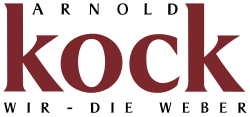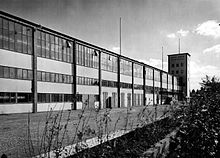Arnold Kock Textile
| Arnold Kock Textile
|
|
|---|---|
| legal form | GmbH |
| founding | 1875 |
| resolution | 2014 |
| Reason for dissolution | Bankruptcy, takeover |
| Seat | Borghorst |
| management | Kock family |
| Number of employees | 130 (2002) |
| sales | 54 million euros (2002) |
| Branch | weaving |
The Arnold Kock Textil GmbH was a German textile company based in Steinfurter district Borghorst . It was founded in 1875 by the textile entrepreneur Arnold Kock . In 2014 the company was taken over by Wilhelm Wülfing and integrated into its operations.
With around 100 employees, the company developed and produced textile fabrics, especially bed linen, table linen, contract textiles, surgical textiles, African damask, kitchen linen and terry towels . In addition to its own weaving mill, there were other production facilities around the world. Production was carried out for various own brands and under license, as well as in the private label business of important customers.
Company history
In 1875, 57-year-old entrepreneur Arnold Kock, who was already involved in several textile companies in Borghorst and Nordkirchen, bought the linen and cotton weaving mill " Brinkhaus und Wischebrink " , which was founded in 1861 and threatened with bankruptcy after the death of the owners, and took over 33 employees . He gave the company the name " Arnold Kock Textil GmbH " and consolidated it.
After his death in 1879, his eldest son Eduard Kock (1856–1926) took over the management, his brothers Arnold Kock (1859–1906) and Franz Kock (1864–1922) also held management positions in the company. In 1885 the company already had 240 employees and operated 400 mechanical looms .
During the First World War , textile production was severely restricted by a lack of cotton imports. You had to switch to substitutes including paper fibers .
In 1927 the weaving mill was consequently converted to modern jacquard looms and branded articles were developed. 1934–38 extensions were built by the architect Heinrich Bartmann .
After the war damage of the Second World War had been repaired, production could be rebuilt. From 1952, new production focuses on damasks , tiling and tablecloths . The brand name Anker is coined, based on a detail of the family coat of arms from 1776. From 1967 acrylic fibers were first used in tablecloths.
The textile crisis in the 1960s to 1990s as a result of globalization resulted in an increased international orientation of the company in terms of procurement , production and sales . In 2002 the company achieved sales of EUR 54 million with around 130 employees. In February 2003, however, bankruptcy had to be filed and the company was then acquired by the Daun Group . On September 1, 2014, the Wilhelm Wülfing company in Borken took over the operations of Arnold Kock Textil GmbH and continued to run it under their name.
literature
- Hans-Jürgen Warnecke: The company foundings of the Kock family , in: Borghorster Heimatblätter, year 1964, issue 3/4
- Hans-Jürgen Warnecke: The historical development of the Borghorster textile industry , in: Westfälische Nachrichten No. 115, Borghorst, May 17, 1968
- Hans-Jürgen Warnecke: From home weaving to the textile industry in: 1000 years of Borghorst, publ. by Wilhelm Kohl, Borghorst 1968, pp. 77-89

